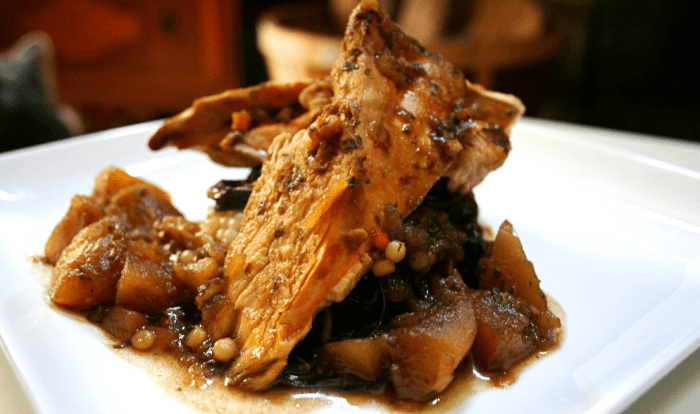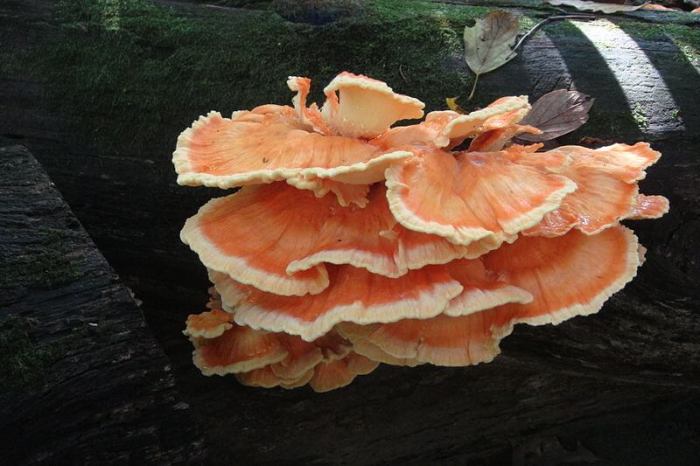
Chicken of the woods recipe – Welcome to the delectable world of Chicken of the Woods! This vibrant mushroom, known for its striking colors and savory flavor, has captivated foodies and foragers alike. Embark on a culinary adventure as we delve into the world of Chicken of the Woods, exploring its nutritional value, foraging techniques, culinary applications, and preservation methods.
From sautéing to grilling, and even pickling, Chicken of the Woods offers a versatile canvas for culinary creations. Discover the secrets to unlocking its unique flavors and textures, and learn how to pair it with complementary ingredients for a symphony of tastes.
Recipe Variations

Chicken of the woods is a versatile mushroom that can be cooked in a variety of ways. Here are a few recipes to get you started:
Grilled Chicken of the Woods
- Preheat your grill to medium-high heat.
- Brush the chicken of the woods with olive oil and season with salt and pepper.
- Grill the chicken of the woods for 5-7 minutes per side, or until cooked through.
- Serve the grilled chicken of the woods with your favorite dipping sauce.
Roasted Chicken of the Woods
- Preheat your oven to 400 degrees Fahrenheit.
- Toss the chicken of the woods with olive oil, salt, and pepper.
- Roast the chicken of the woods for 20-25 minutes, or until cooked through.
- Serve the roasted chicken of the woods with your favorite side dishes.
Sautéed Chicken of the Woods
- Heat a large skillet over medium heat.
- Add the chicken of the woods to the skillet and cook for 5-7 minutes, or until cooked through.
- Season the chicken of the woods with salt and pepper to taste.
- Serve the sautéed chicken of the woods with your favorite side dishes.
Marinades, Seasonings, and Sauces
Chicken of the woods is a great mushroom to experiment with different marinades, seasonings, and sauces. Here are a few ideas to get you started:
- Marinades:Try marinating chicken of the woods in olive oil, lemon juice, garlic, and herbs for a flavorful dish.
- Seasonings:Season chicken of the woods with salt, pepper, garlic powder, and onion powder for a simple but delicious flavor.
- Sauces:Serve chicken of the woods with your favorite dipping sauce, such as barbecue sauce, ranch dressing, or teriyaki sauce.
Nutritional Value and Health Benefits

Chicken of the woods is an excellent source of various nutrients, including vitamins, minerals, and antioxidants. It is a good source of dietary fiber, vitamin C, potassium, and iron. It also contains significant amounts of antioxidants, such as ergothioneine and phenolic compounds.
Health Benefits
Several studies have shown that consuming chicken of the woods may provide various health benefits, including:
- Immune system enhancement:Chicken of the woods contains polysaccharides, which have been shown to stimulate the immune system and enhance the body’s ability to fight infections.
- Anti-inflammatory properties:Chicken of the woods contains compounds that have anti-inflammatory effects. These compounds may help reduce inflammation in the body and protect against chronic diseases associated with inflammation.
Potential Risks and Precautions
While chicken of the woods is generally safe to consume, there are some potential risks and precautions to consider:
- Allergic reactions:Some people may be allergic to chicken of the woods. Symptoms of an allergic reaction may include skin rashes, itching, swelling, and difficulty breathing.
- Digestive issues:Consuming large amounts of chicken of the woods may cause digestive issues, such as gas, bloating, and diarrhea.
- Interaction with medications:Chicken of the woods may interact with certain medications, such as blood thinners and immunosuppressants. It is important to consult with a healthcare professional before consuming chicken of the woods if you are taking any medications.
Foraging and Identification

Chicken of the woods mushrooms, prized for their vibrant colors and delectable taste, thrive in various forest ecosystems. However, it’s crucial to approach foraging with caution, as mistaking poisonous mushrooms for edible ones can have severe consequences.
Have you ever heard of the delectable chicken of the woods mushroom? If not, then you’re in for a treat! This culinary delight has a unique texture and flavor that resembles chicken. You can find numerous chicken of the woods recipes online, but if you’re looking for something truly exceptional, I highly recommend checking out the recipe from Jackson County.
Their chicken of the woods recipe is a symphony of flavors that will tantalize your taste buds.
Physical Characteristics
- Color:Chicken of the woods mushrooms exhibit a striking range of colors, from bright yellow to deep orange. As they mature, their hues may transition to a more subdued golden or brownish tint.
- Shape:These mushrooms typically form large, shelf-like structures, resembling clusters of chicken breasts. Their edges may be lobed or ruffled, giving them a unique appearance.
- Texture:When fresh, chicken of the woods mushrooms possess a firm and meaty texture. However, they can become tough and rubbery as they age.
Responsible Foraging Practices
To ensure a safe and sustainable foraging experience, it’s essential to follow responsible practices:
- Identification:Before consuming any mushroom, be absolutely certain of its identity. Consult field guides, consult with experienced foragers, or seek professional identification assistance.
- Respect the Ecosystem:Harvest mushrooms sustainably, taking only what you need and leaving the rest for others to enjoy. Avoid disturbing the surrounding environment or damaging the mushroom’s mycelium.
- Avoid Poisonous Mushrooms:Never consume a mushroom you cannot confidently identify. If you have any doubts, discard it immediately.
Culinary Applications: Chicken Of The Woods Recipe

Chicken of the woods is a versatile culinary ingredient that can be used in a wide variety of dishes. Its meaty texture and savory flavor make it a great substitute for chicken in many recipes.
Chicken of the woods can be used in salads, soups, stews, and other dishes. It can be grilled, roasted, fried, or sautéed. When cooked, it develops a slightly crispy exterior and a tender, juicy interior.
Pairing Chicken of the Woods with Complementary Ingredients
Chicken of the woods pairs well with a variety of flavors, including:
- Herbs: thyme, rosemary, oregano, sage
- Spices: garlic, onion, paprika, cumin
- Vegetables: mushrooms, bell peppers, onions, carrots
- Fruits: apples, pears, cranberries
- Nuts: walnuts, pecans, almonds
- Cheeses: goat cheese, blue cheese, cheddar
Preservation and Storage
Preserving and storing chicken of the woods properly ensures its longevity and maintains its nutritional value. Here are some effective techniques:
Drying
Drying is a great way to preserve chicken of the woods for extended periods. Slice the mushroom thinly and dehydrate it using a food dehydrator or in a warm, dry place with good air circulation. Once fully dried, store the pieces in an airtight container in a cool, dark place.
Freezing, Chicken of the woods recipe
Freezing is another excellent preservation method. Clean and cut the mushroom into desired sizes. Blanch the pieces briefly in boiling water to retain their texture and color. Allow them to cool completely before freezing them in airtight containers or freezer bags.
Canning
Canning is a safe and effective method for long-term storage. Prepare the mushroom by cleaning, slicing, and cooking it thoroughly. Pack the cooked mushroom into sterilized jars, cover it with a canning liquid (such as vinegar or brine), and process it in a pressure canner according to recommended guidelines.
Storage
Fresh chicken of the woods should be stored in a paper bag or loosely wrapped in a damp cloth in the refrigerator. It can last for several days when stored properly.
Dried chicken of the woods can be stored in an airtight container in a cool, dark place for several months.
Frozen chicken of the woods can be stored for up to a year.
For those looking for a delicious and unique vegetarian meal, the chicken of the woods recipe is a must-try. This edible fungus has a meaty texture and a savory flavor that resembles chicken, making it a great substitute for meat-based dishes.
Whether you’re a seasoned chef or a beginner in the kitchen, this recipe provides easy-to-follow instructions that will guide you through the process of preparing this culinary delight.
Determining Spoilage
Spoiled chicken of the woods will have an unpleasant odor, slimy texture, or discoloration. Discard any mushrooms that exhibit these signs.
Last Recap
As we conclude our exploration of Chicken of the Woods, we celebrate its versatility, nutritional benefits, and the joy it brings to our culinary adventures. Whether you’re a seasoned forager or a kitchen novice, we hope this guide has inspired you to embrace the wonders of this woodland delicacy.
So, gather your baskets, sharpen your knives, and prepare to savor the unforgettable taste of Chicken of the Woods.
Essential FAQs
Is Chicken of the Woods safe to eat?
Yes, Chicken of the Woods is generally considered safe to eat when properly identified and cooked. However, it’s crucial to note that there are poisonous look-alikes, so it’s essential to consult a reliable field guide or consult with an experienced forager before consuming.
How can I store Chicken of the Woods?
Chicken of the Woods can be stored in the refrigerator for up to a week. For longer storage, it can be dried, frozen, or canned. Drying is a great way to preserve its flavor and extend its shelf life.
What are the health benefits of Chicken of the Woods?
Chicken of the Woods is a good source of dietary fiber, antioxidants, and vitamins. It has been shown to have anti-inflammatory properties and may support immune function.